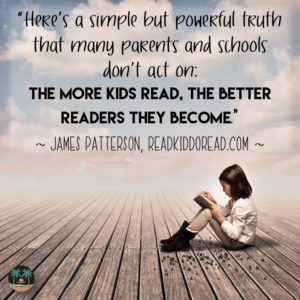What Makes a Good Reader?
Are you wondering how to engage your kids with reading? It doesn’t matter how old your child is — 2 or 15 — the answer is the same.
The other day, one of my friends asked me if her third-grade son’s reading MAP score of 225 was “normal.” If you’re not familiar with MAP, it’s a nationally normed, computer-based assessment (Measures of Academic Progress) which gives educators a very loose idea of reading achievement (and should never be considered the sole determiner of success, but that’s a topic for a different post). After sharing with my friend that her son’s MAP score was actually way above normal for a third-grader, she was surprised. “Math is normally his strength,” she told me, to which I responded, “If you are reading with him at home every day, he will always excel at comprehension, even if he’s better at math.” I’m not quite sure she believed me.
When I was taking course work for my Reading master’s degree, I remember being in the middle of a dilemma with a freshman student who was struggling with reading comprehension. I contacted his parents to share my concerns, and the mother told me that she just didn’t know what to do to help him. “He’s always struggled with reading. He just doesn’t like it. What do you think I should do?” As I was in the midst of earning my reading specialist certification, I felt I should have an answer, but I didn’t. It seems like such a common question: What makes a good reader? Yet, the answer wasn’t obvious at the time, and it still isn’t for most people. When I took this issue to my professor, the simplicity of his answer shocked me. “Did you ask her how often he reads at home?”
Here’s the thing. Reading comprehension issues have been turned into something much larger than they really need to be. In order for kids to be better readers and writers, they need to READ. EVERY. DAY. However, the majority of this reading needs to take place at home. The reason reading comprehension is now embedded in many middle and high school English curriculums is because students are not being encouraged to read at home, and reading may or not be modeled for them outside the school day.
Many schools have adopted reading challenges to try to compensate for the lack of reading exposure at home through programs like the Million Pages of Books, Drop Everything and Read, and Knowledge is Power. Some teachers are encouraging independent reading time or setting aside a certain number of minutes during each class period for students to engage with books. These steps are admirable, and educators should do everything they can to positively impact students’ perceptions of reading; every little bit helps. BUT. It’s not enough without support at home.
Parents will either directly or indirectly teach their children to learn to love reading, hate reading, or feel indifferently toward it whether they try or not. So what is the difference between the child who excels at reading and the one who hates it? Practice. Let’s look at some ideas for how parents can raise a child (a toddler or a teen) who appreciates and excels at reading.
Read Daily
Find at least twenty minutes a day where you can sit down and read with your child. Younger children need to be read to. School age children can take turns reading with you, you can read to them, or you can listen to them read. Teenagers might feel silly sitting down and listening to a parent read to them; if that’s the case, spend twenty minutes sitting by your teen while you both read, and then talk about the text with your child.
Allow Freedom & Cater to Interest
Go to the library. Go to a bookstore. Check out Amazon. Borrow books from friends. Explore various genres. Spend some time learning about what your child likes and dislikes by trying different types of texts. There’s nothing wrong with graphic novels, news articles, the Guinness Book of World Records, and magazines. Allow kids to read books on a nook or kindle or to use an audiobook as they follow along. One of my children’s favorite books is a Charlie Brown Christmas book which features a recording of their grandparents reading the book out loud. Don’t ask your child to shy away from a book because you think it’s too difficult or too easy. Let’ them come to that conclusion on their own. Giving children ownership in the decision-making process will help them develop independence and a positive attitude about reading. If you’re not sure where to start looking for ideas, check out these resources:
- Oprah’s Book Club: Kids’ Reading List
- Jame’s Patterson’s Read Kiddo Read
- Guys Read
- American Library Association
- Abraham Lincoln Teen Choice Award Winners
- Drop Everything and Read
Model Reading
Let your kids see you reading books, magazines, newspapers, instruction manuals, picture books, the Bible — you name it! Modeling reading is just as effective as modeling anything else: good behavior, working out, cleaning, eating healthy. Children of any age are impressionable. Obviously, it’s better to start when your kids are young, but it’s never too late. Many of us are doing a disservice to our children by prioritizing other things (like being on our phones) over reading. Reading in front of and to our children is not only a responsibility, but also a privilege.
Keep Books Everywhere
Studies have shown the amount of books in a home is related to literacy skills. We have several bookshelves in our home, but I also intentionally leave books in random places so that my children will be more likely to pick them up. We have books next to the time-out chairs. I encourage my children to read when they are in time out to help them calm down. Reading is a healthy life coping skill for many people. I also allow my children to put five to ten books at the foot of their bed at night time. If they have difficulty falling asleep or if they wake up before their alarm goes off in the morning, they read them. We have books on our coffee tables and in baskets. My one-year-old likes to pick these books up and flip through them. He points to different pictures and feels the textures, even when I don’t have time in that moment to read the book to him. Long story short — keep books everywhere.
Stay Positive
When reading with our children at home, it can be easy to get frustrated. Let me give you some examples that are inspired by my own 3 and 5 years olds:
- They don’t want to read the same book, so they fight.
- They can’t agree on who should turn the page.
- They like to talk over each other when asking questions.
- One wiggles and puts their arm in front of the other’s face.
- One asks questions just to draw the reading process out further so that he doesn’t have to go to bed.
I could go on, but you get the point. These examples apply to younger kids, but with older ones, a unique and different set of issues exist. Still, it’s important as parents that we stay calm and positive. If I were to close the book and say, “You guys never get along while we read, so we are done,” that would leave my children with a negative view of themselves and of reading. Instead, try to have patience, and devise ways to make reading more engaging and less stressful both for you and for your child. If you need some ideas, stay tuned for the next article in this series, which will be about ways parents can enjoy books with their children.
While parents read with their children at home, educators need to continue fighting the good fight in the classroom. Teach reading strategies, model what it looks like to think about books, plan for reading time during class, allow freedom to choose texts, praise progress, and educate parents about the magnitude of their role at home. The most powerful tool we wield to impact children’s’ view of themselves as readers is to encourage them to read every day and to support them in doing so.
Experienced parents and teachers, what advice can you offer others regarding reading at home with children?
Interested in related content? Click here to read about how to engage boys with books and here for tips on how parents can help older students who already hate reading.




